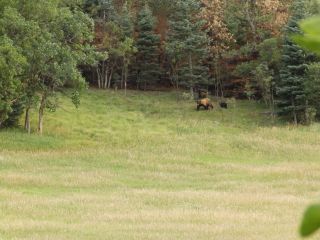Fear
I've Met the Bear, and I Would Still Choose It
Personal Perspective: In the "Man vs. Bear" debate, neither choice feels safe.
Updated September 14, 2024 Reviewed by Davia Sills
Key points
- Women are debating if they would rather meet a man or a bear in the woods. Most choose a bear.
- It is a simple exercise in women's perception of danger but offers an artificial choice.
- I’ve coexisted with bears for more than 30 years. I know how to avoid them.
- I’ve not thought about being frightened of men, but my behavior shows I am.

My last interaction with a bear was on the remote mountain road by our Colorado cabin. A black bear came out of the woods about 100 yards ahead of where my husband and I were walking. We’ve been coming here for 30 years, and, in the past, if a bear looked down the road and saw humans, it would run as fast and far as it could. Not this time.
The bear stopped in the middle of the road and stared at us. Bears don’t have great eyesight, so, at that distance, he could see our shapes but likely didn’t know what we were. Prey or predator.
We slowly backed up, as recommended by bear experts. The bear watched, then took a short leap forward as though to charge, but stopped. A warning. I pulled my bear spray out and put my finger on the nozzle. I’ve never used bear spray, and I hoped it would work if we needed it.
I was prepared and knew what to expect. The bear, I was sure, would ultimately retreat. It did, turning and lumbering off onto a side path. We stood in place for several minutes, then walked forward slowly, carefully watching the route he’d taken. I kept my finger on the bear spray.
According to a recent internet debate, most women would rather meet a bear in the woods than a strange man. With a bear, you generally know what to expect. A bear is most likely to leave you alone unless it has cause to fear you, especially if you’ve surprised it or come between a mama and her cubs. Then, it reacts to protect itself. A man can be less predictable. He could be, like most men we know, kind and helpful. But he might not be, and we have no idea how to tell the difference.
I’ve had many bear encounters. The most frightening one came during multiple nights when a 2-year-old male, newly orphaned in a forest fire, repeatedly tried to break into our cabin. My husband had made an aromatic meal on the grill earlier that day, which is what drew the bear. As usual, though, he cooked on a baking sheet to keep food from sticking to the griddle. The food lured the bear, but finding nothing edible outside, it tried to come inside.
We had a small window open, which I shut while the bear panted in my face. He left, once he knew we had nothing for him. We came out OK, but sadly, the bear didn’t. He was seen as a threat to other humans—once a bear breaks into a home, it becomes a risk, and if it is caught, it is euthanized. This one was caught. The poor, hungry kid lost its life, and 10 years later, I have lingering PTSD.
So that’s the bear. Now, the man.
Is That Man Dangerous or Just a Good Dad Out for a Hike?
I was recently on a trail in the Green Mountains of Vermont by our daughter’s house. I had walked up a small hill and stopped to look at the view. At the bottom, I saw a man looking up at me. This was unnerving. I looked directly at him and picked up my cell phone as though to call somebody. He turned and, like the bear, went the other direction.
I have no idea what to expect when I face men I don’t know. Why was that man on the Vermont trail looking at me? Was he just curious about what was up there? Or was he in the minority who see women as easy prey? Or, worse, was he one of those increasingly vocal, angry men who now find it OK to express their disdain for women and flaunt their power over us?
Even in the park across the street from our condo in the middle of Des Moines, Iowa, I avoid paths through the woods, staying on well-traveled roads instead. There are no bears in the middle of Des Moines. How do I know if a man I meet is a threat? It’s a safe park, but it is sparsely used during my morning walks. Is that glowering man coming toward me dangerous, or is he just a lawyer who’s having a bad week? Or both?
I’m surprised it took me so long to acknowledge that my perception of safety is partially based on a fear of strange men. I simply have always done what other women do: lived in protective mode. I pay attention to my surroundings, avoid solitary areas, have my keys in hand to use as a weapon, and keep my cell phone ready to call 911.
Sadly, I feel more of a sense of menace now, from bear and from man. The bear’s behavior has been changing because we’ve encroached on its land so much that we live together more than we used to, and the bear has lost some of its fear. Our land in Colorado, with 360 acres and only three small summer homes, is a good place for bears. We respect them, and we coexist fine. But a recent fire burned trees that provided shade for the grass and shrubs bears eat, so they are more likely to look to our cabins for dinner. And people are building more and more homes in bear country, with food in garbage cans and grills and bird feeders. The bears have become habituated—accustomed to humans—and that’s not good for them or for us.
On the other hand, constant messaging on social media, talk radio, and podcasts tells men that women have become too powerful—that we are the threat, not them. And what do you do with a threat but try to control, or at least minimize it? And the bear is also threatened by the man. Like women, it has always been both prey and trophy.
I wonder if many women (most?) have PTSD because of the implicit fears of our existence. I faced a real threat from a bear, but so far, I have not been even remotely threatened by a man—or I wasn’t aware of it if I was. Yet I fear them equally and am always on alert when I am walking alone. That’s unfair to the many bears minding their own business and to the men who are helpmates rather than threats. But we cannot know which has become aggressive and is a risk to us and which isn’t when we’re out enjoying nature, as should be our right. So we carry keys and pepper spray and try to enjoy the scenery.




